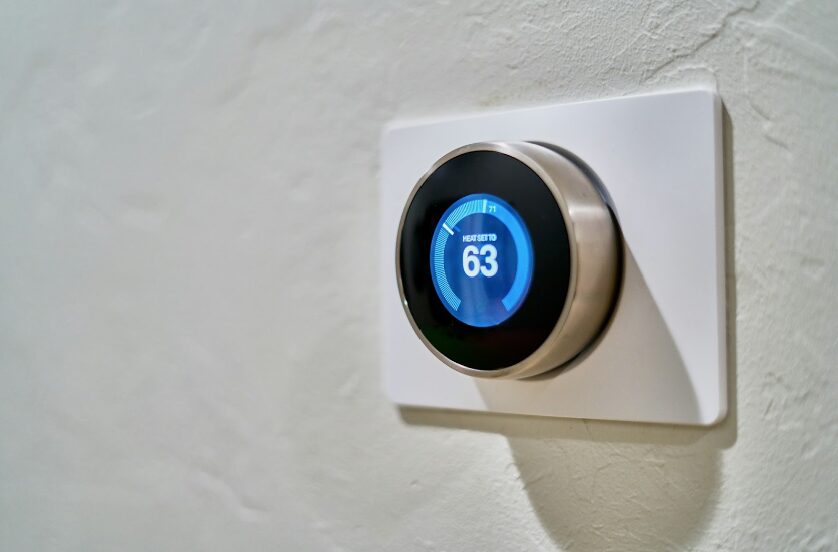Warming temperatures can signal the start of lazy summer days spent poolside or soaking up the sun at the beach, but there’s another side to the building heat, too. Unfortunately, the mercury isn’t the only thing that rises in the summer. Your home cooling bill and the risk of sickness or injury due to heat exposure increase as well. Here are 13 ways to stay safe and cool in your home, no matter how scorching it gets outside.
1. Get Your Air Conditioning Tuned Up
Regular maintenance of your HVAC system helps it work more efficiently during peak hours. This saves you money, ensures proper home cooling in the heat of the day, and helps avoid unexpected breakdowns. The same applies to window unit air conditioners. Change filters at the end of each season so air conditioners are ready to go in the summer, and keep vents clean and clear.
2. Use a Smart Thermostat
Smart thermostats can be programmed to kick into action and turn off at regular times to optimize cooling efficiency and save money. Consider setting it up to cool your home less aggressively during periods when it is unoccupied, reserving chillier temperatures for later in the day and at night to make sleeping more comfortable.
3. Capitalize on Ceiling Fans
People in the South are well-versed in using ceiling fans to keep their homes cool, but if you’re planning a move to a hotter climate, get ready to use this simple cooling system frequently. Most ceiling fans can rotate clockwise or counterclockwise, depending on the season. In the summer, set ceiling fans to rotate counterclockwise to push cool air down.
Portable fans can also circulate air through your home. This is a good idea if you don’t have opposing windows facing the direction in which breezes generally blow. In addition, both portable and ceiling fans help your AC by circulating cool air throughout the house.
4. Add a Dehumidifier
Damp air can make your home feel hotter than it actually is by keeping your body from cooling itself efficiently through sweat. Adding a dehumidifier to your selection of cooling equipment removes moisture from the air and makes indoor conditions more comfortable, no matter the temperature.
5. Keep Things Dark
That large wall of windows in your home may create a bright and airy feel, but it also lets in a lot of heat in the summertime. As the day progresses, use blackout curtains or blinds to block out direct sunlight. You can also apply reflective film to the outside of windows to block some heat and reduce indoor temperatures. This is a good option if preserving your view and natural light are among the most important factors to you.
6. Insulate Your Home Properly
Most people think of insulation only when winter sets in, but proper insulation is also critical to keep cooler air inside the home. Use weather stripping to seal gaps around windows and doors, and add more insulation to walls and attics to keep summer heat out and your valuable air-conditioned air in.
7. Replace Windows
Replacing windows can be expensive and time-consuming, to be sure. But if you have old, uninsulated windows without a UV protective coating, your heating costs will likely become an issue. If you cannot afford to replace all your windows at once, consider replacing those that get the most sun in the summertime first.
8. Take Advantage of Natural Ventilation
Take a tip from your neighbors below the Mason-Dixon line: Open windows in the early morning and evening when the air is cooler and close them when the heat begins to rise. When windows are on opposite sides of the home, this provides the best cross-ventilation.
9. Reduce Indoor Heat Sources
New energy-efficient lighting emits next to no heat compared to traditional light bulbs, so swap old ones for more cost-effective and cooler LEDs. You can also reduce heat inside by minimizing your use of ovens, stoves, and clothes dryers during the day. Instead, take the cooking outdoors by grilling and dining al fresco.
10. Create a Cooling Zone
If you do not have central air conditioning and your budget is tight, consider creating a cool zone in one room. Use fans and air conditioning at strategic times and close off other areas. A cool zone works best in lower areas of the home, such as finished basements, which are great for escaping the heat at the hottest part of the day.
If you have recently moved in with someone, it might be challenging to create just one cool room; consider cooling adjoining areas like an open-plan kitchen/living room for a little more space.
11. Stay Hydrated
Even if you are inside staying cool, keeping hydrated is essential. Even if you are not thirsty, drinking plenty of water or hydration beverages and consuming juicy fruits and vegetables in the summer months is important. Keep an eye on your vulnerable family members, too; dehydration can be especially dangerous for infants and the elderly.
12. Practice Cooling Techniques
If you have just finished an activity outside and are feeling overheated once you’ve returned indoors, apply cold compresses or damp cloths to your wrists, neck, and forehead to cool down quickly. You can also take cool (not cold) showers or baths to lower your body temperature.
13. Make Changes Gradually
Adding an entirely new HVAC system or mini splits can put a big strain on your finances, but you don’t have to make all of these changes at once. Even if you cannot upgrade your AC all at once, making even small changes can help you beat the heat and stay safe and cool in the hottest months of the year.
5 Tips to Improve Your Air Conditioner Efficiency


